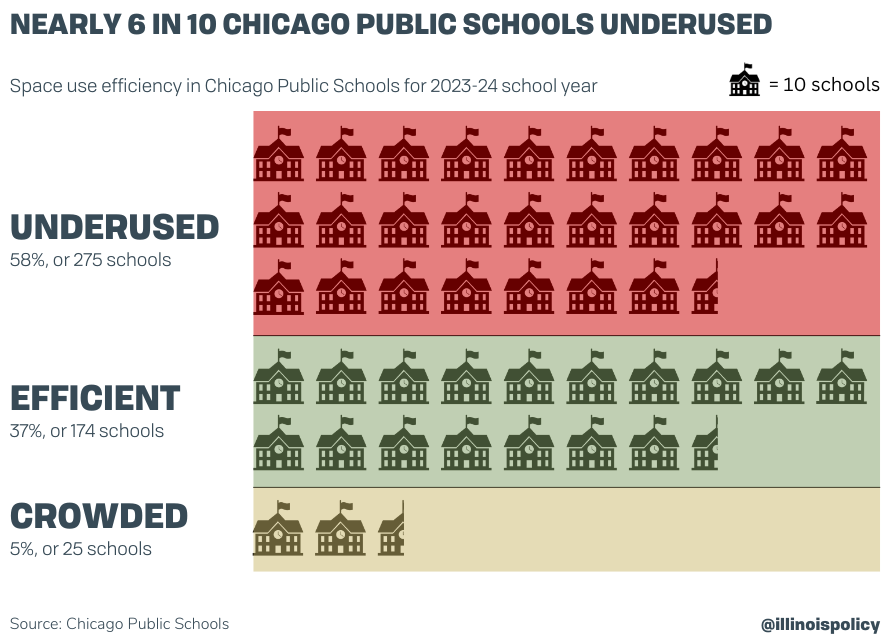Will back to school in Chicago Public Schools be back to same-old, same-old?
Chicago Public Schools students return to class Aug. 26. Here’s what parents should know about academics, building use, enrollment, absenteeism and finances.
Chicago Public Schools students return to school Aug. 26, with thousands in schools with mostly empty seats and few students meeting grade-level standards.
Look at how the district is faring and what students can expect as they return to classrooms. Here’s a hint: poor proficiency, fewer students and increased spending.
Proficiency in CPS
The most recent test scores available for CPS students show few are meeting grade-level standards in reading and math. In 199 schools, just 1-in-10 students met those proficiency standards.
Student achievement improved in 2023, bringing rates closer to but still below pre-pandemic levels. In spring 2023, the Illinois State Board of Education reported 26% of Chicago third- through eighth-grade students could read at grade level, edging closer to the 27% from spring 2019. Only 18% were proficient in math this spring, compared to 24% in spring 2019.
Chicago’s high schools are also struggling. Just 22% of Chicago 11th graders could read at grade level and 19% performed math proficiently in spring 2023. The SAT is taken by all 11th grade students each spring to measure proficiency for high school students.
Additionally, there were many schools where not a single student in a given grade could read or do math at grade level.
In 2023, there were 25 CPS schools in which no third-grade students scored at grade level in either reading or math and as many as 29 schools in which no fifth-grade students hit those marks. There were also 26 schools in which no 11th grade students scored at grade level.
Third grade is a critical reading milestone because students need to have learned to read by then or they will not be able to absorb the rest of their education. In 55 schools, not a single third-grade student could read at grade level.
Near empty spaces
CPS school building use varied in 2023-2024, with some nearly empty and others overcrowded. More than 3 in 10 seats in CPS schools remained empty during the school year. In many schools the rate was higher.
The district reports 58% of schools – or 275 schools – were underused in the 2023-2024 school year, 37% were efficiently used and 5% were overcrowded.

The average “space utilization rate” in the 2023-2024 school year is 65% across 474 schools, according to district data. That means the average school in CPS has 35% of its seats empty.
The 10 emptiest schools in CPS were at just 12% capacity on average, ranging from 4% at Douglass Academy High School to 16% at Sumner Elementary School.
Douglass Academy High School had only 35 students in the 2023-2024 school year. It employs 21.5 staff members for a staff-to-student ratio of 3:5. Reading and math proficiency rates were redacted in spring 2023 because of ISBE’s rules for results involving fewer than 10 students. But the most recent test data available shows no 11th-grade students could read or perform math at grade level on the SAT in the 2021-2022 school year, and 86% of tested students scored in the lowest reading proficiency level. Douglass Academy’s chronic absenteeism rate was 64%.
These poor results came at a price of $68,091 per student. That’s nearly $50,000 more per student than the district average.
There were more successful outcomes and efficient spending among the 10 most overcrowded schools in CPS compared to the 10 emptiest schools.
Enrollment and student-teacher ratios
CPS enrollment rose by nearly 1,200 students in the 2023-2024 school year to 323,291 students, according to the district’s official enrollment report.
This marks the first rise in enrollment since 2011, likely because of the influx of thousands of migrant children, according to the Chicago Sun-Times.
Despite the increase, there are still 38,000 fewer students than before the pandemic. During the 11 years of enrollment decline starting in the 2011-12 school year, the district lost nearly 81,000 students. Last year’s decline cost CPS its status as the nation’s third-largest school district.
The racial makeup of the district changed slightly, with the largest increase being nearly 2,000 more Hispanic students. The largest drop – and largest change overall – came from Black students with 2,100 fewer enrolled this school year compared to last school year.
The only other racial or ethnic group to decrease was the Hawaiian and Pacific Islanders group by just 42 students.
Despite a dramatic overall decrease in enrollment, there are more staff employed by CPS to help educate fewer students.
Employee rosters show employment in CPS increased by 5,472 full-time staff members between December 2019 and December 2023 despite a decrease of 31,905 students during that same period. That’s a 15% boost in full-time staff during a 9% drop in enrollment.
More staff and fewer students but there remained 2,182 unfilled teaching positions as of October.
Students skipping school
Chronic absenteeism in CPS remained high in 2023 after it “skyrocketed during the pandemic,” according to a press release from ISBE.
Nearly 40% of CPS students were chronically absent in the 2022-2023 school year, meaning they missed 10% or more of their school days with or without a valid excuse. That compares to a statewide rate of 28%.
The rate is even higher among Chicago’s low-income students, who were disproportionately affected by pandemic-era school closures. Nearly 44% were chronically absent in 2023, compared to 26% in 2019.
High absenteeism is a warning sign, as research suggests frequent absences put students at a higher risk of poor outcomes, such as dropping out of school and lower academic achievement.
More and more money
CPS is operating on larger and larger budgets each year, despite schooling fewer and fewer students and producing worse academic results.
CPS administrators have proposed a 2025 budget topping $9.9 billion – up $505 million from the 2024 budget. The budget includes $149 million in additional school-level funding, $38 million in new funding for students’ physical, mental and emotional well-being, and $611 million in capital spending after the capital budget was scaled down to $155 million in 2024.
Despite the increase in spending, the district was still facing a $505 million deficit for the upcoming year as growth in expenses continues to outpace growth in revenues. That deficit is without cost increases from a new contract with the Chicago Teachers Union. District administrators estimated if CTU wins just 52 of its over 700 contract demands, CPS will face a $2.9 billion deficit next year that is projected to grow to nearly $4 billion by fiscal year 2029. An Illinois Policy Institute analysis put the cost in excess of $10.2 billion from 2025-2028 for the CTU demands that can be estimated.
Another reason for the existing $505 million deficit is nearly $2.8 billion in temporary federal pandemic-related aid has been built into the district’s spending base since 2020. That money is set to decline by $504 million this year – from $737 million in 2024 to $233 million in 2025 – as CPS expends the last of its federal funds. Coincidentally, CPS’s 2025 budget shortfall tallied $505 million – virtually the exact amount of the reduction in temporary federal aid.
Anticipated budget shortfalls plus a new, expensive contract with CTU is bad news for taxpayers. Just how bad depends on negotiations.
Looking ahead
As the new school year begins, CPS leaders should be looking to address these critical issues of low proficiency, underutilized buildings and more. It is necessary to better allocate financial resources so students can thrive.
The Chicago School Board leaders should be looking to address facility utilization and prioritize coming up with better district staffing models and resource allocation to make better use of the buildings that sit empty and allow educators and school staff to improve student learning. Allowing CTU to continue driving up costs and allowing student achievement to continue suffering as families flee is a threat to all Chicagoans.
